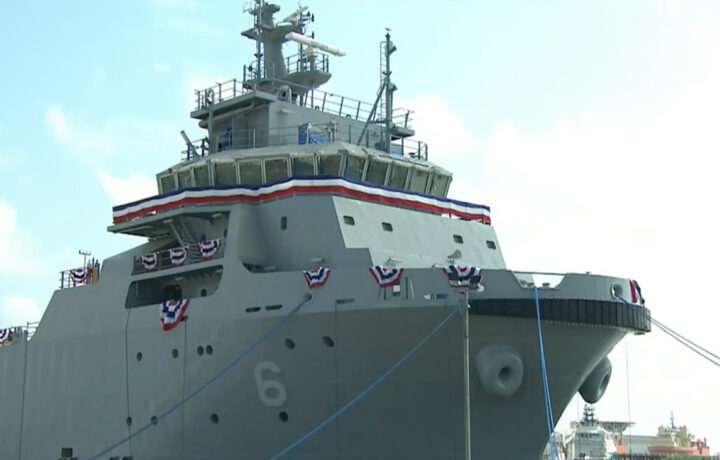The United States Navy will soon have a new class of vessels in service – and though it isn’t anything as glamorous as a new aircraft carrier, it will play a crucial role in the fleet. On Saturday, August 26, the U.S. Navy christened the future USNS Navajo (T-ATS 6), the lead vessel of a new class of towing, salvage, and rescue ship at Bollinger Shipyards in Houma, LA.
The vessel was ordered in 2017 as the planned replacement for the U.S. Navy’s aging Safeguard-class of rescue and salvage ships, as well as the Powhatan-class tugboats. The former class entered service in the early 1980s, while the first of the latter vessels dates back to the late 1970s. The Navy had planned to build five of the Safeguard-class, and four were subsequently built – with two already retired. All of the Powhatan-class tugs have been retired, except for the USS Catawba, which is due to retire by the end of this year.
The New Class to Fill Two Roles
The lead ship and the first batch of six additional vessels were laid down in 2019, while two additional ships were ordered a year later.
“This isn’t just any ship; it’s the first of its kind. This is a Bollinger-built Navajo-class Towing, Salvage, and Rescue Ship manufactured to the highest level of craftsmanship and quality,” said Ben Bordelon, president and CEO of Bollinger Shipyards. “Every weld, every beam, every system on this ship was crafted with the thought of the warriors that inspired its name. It is an honor beyond words for Bollinger to partner with the Navy. The trust bestowed upon us to construct a new class of vessel is both a responsibility and a privilege that we hold dear.”
The lead vessel was named in recognition of the Navajo tribe and the Diné people and was meant to recognize their many contributions to the U.S. military and the country’s defense.
“This ceremony signifies more than the unveiling of a new class of towing, salvage and rescue vessels. It is an homage to the Navajo people’s rich military legacy,” said Justin Ahasteen, executive director of the Navajo Nation’s Washington Office. “Navajo warriors throughout history have tirelessly shielded our nation. From the legendary Navajo Code Talkers of World War II to the brave Navajo men and women serving today, our nation embodies the spirit of warrior protectors and defenders.”
Bollinger is also constructing USNS Cherokee Nation (T-ATS 7) and USNS Saginaw Ojibwe Anishinabek (T-ATS 8), and is under contract for USNS Lenni Lenape (T-ATS 9) and USNS Muscogee Creek Nation (T-ATS 10).
The subsequent ships of the class will be named for other Indigenous nations.
More Navajo-class Set to Join the Fleet
In late 2021, Austal USA was awarded a $145 million contract to build T-ATS 11 and 12, with options for up to three additional ships of the class – and it was last July that two more Navajo-class vessels were ordered.
The defense contractor is currently scheduled to start construction of the T-ATS 13 in the second half of the calendar year (CY) 2023 and the T-ATS 14 in the first half of CY2024. Planned to be built at Austal’s steel production facility, the T-ATS 13 is projected to be delivered in the second half of CY2025, while the second vessel will be handed over by the first half CY2026.
Towing, Salvage, and Rescue
The Navajo-class was developed to serve as a new series of towing, salvage and rescue ships (T-ATS), and each vessel is a multi-mission common hull platform that will be deployed to support a range of missions such as towing, rescue, salvage, humanitarian assistance, oil spill response and wide-area search and surveillance operations using unmanned underwater vehicles (UUV) and unmanned aerial vehicles (UAV).
Each of the ships will displace 5,110 long tons (5,190 tons) and will have a length of 263 feet (80 meters) with a beam of 59 feet (18 meters). The ships are powered by a pair of diesel Wartsila 8L32 engines, which provide 6,308 Hp. The Navajo-class vessels can reach a top speed of 15.1 knots, and have a range of 8,170 nautical miles.
The complement is 42 sailors.
“This class of ship is critical to ensure our sailors and mariners receive critical, timely support and stay forward around the globe defending our interests,” said Vice Admiral Craig Clapperton, Commander, Fleet, Cyber Command and Commander, Tenth Fleet. “And they will sail wherever international law allows and operate right to the edge of controversy to ensure a free global common for all. These multipurpose ships also stand ready to respond quickly in the event a disaster strikes, providing critical humanitarian assistance, firefighting support and spill response. A special capability that few can provide.”
While the Safeguard-class was operated by the U.S. Navy, the USNS Navajo along with the other ships in its class will be operated by the Navy’s Military Sealift Command (MSC), the organization that controls the replenishment and military transport ships of the United States Navy. It has the responsibility for providing sealift and ocean transportation for all US military services as well as for other government agencies.
The Navajo-class will be well-suited to the needs of the MSC.
“The T-ATS 6 combines two classes of ships for your nation and your Navy,” explained Rear Admiral Jeffrey Spivey, deputy commander, Military Sealift Command. “It combines those into one class that is more capable than any ship we have out there in this salvage class.”




